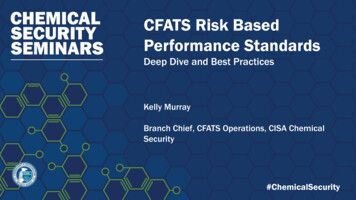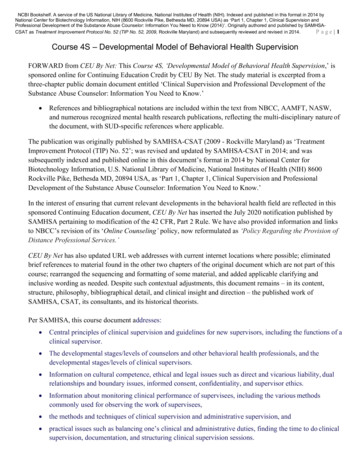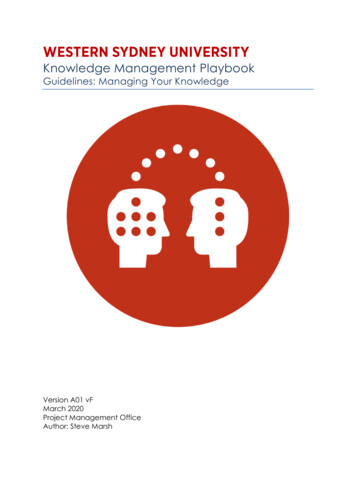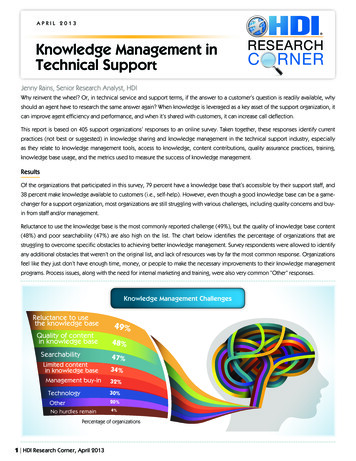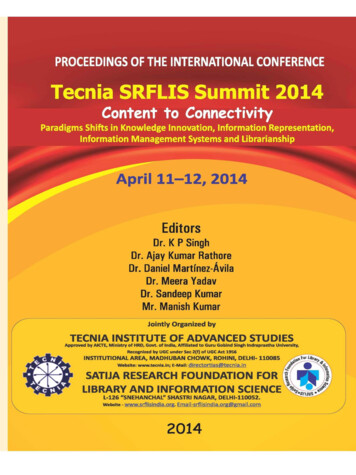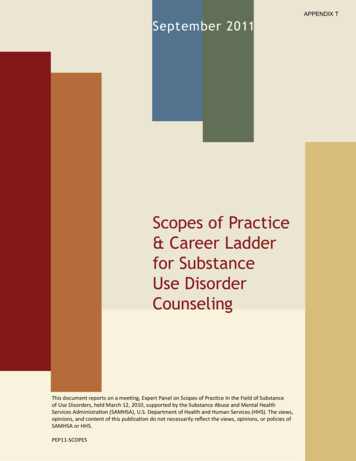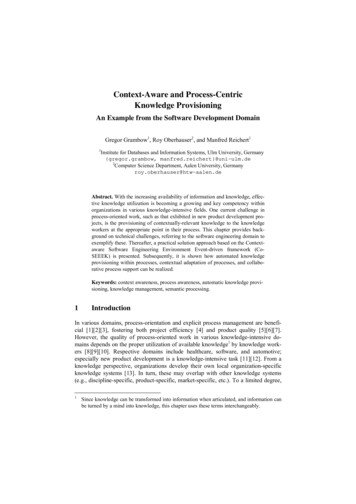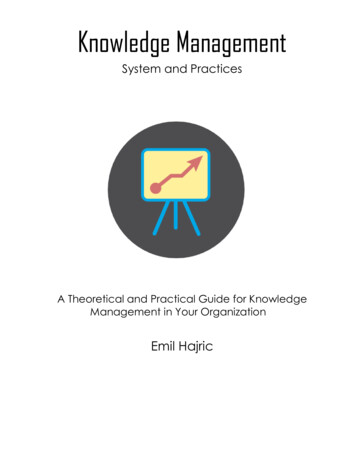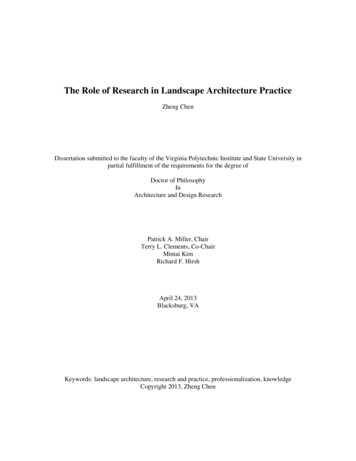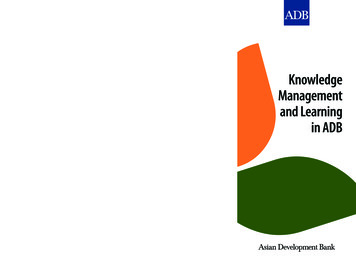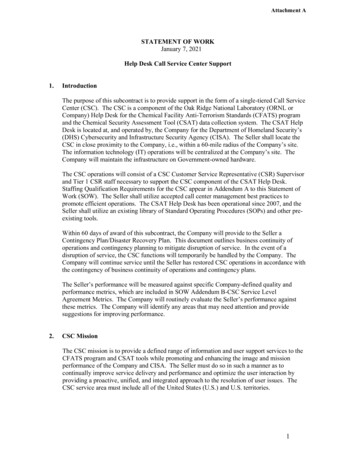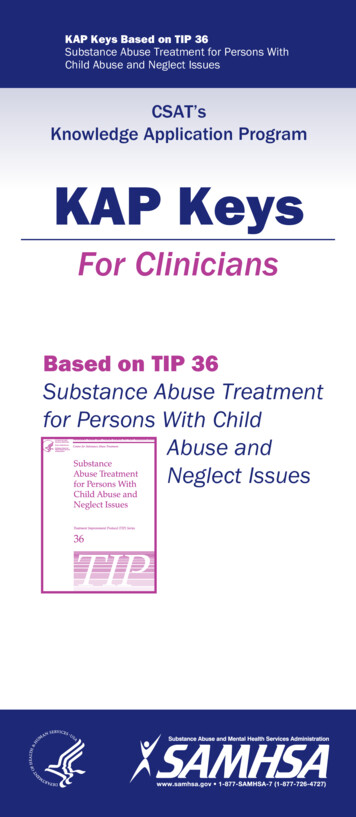
Transcription
KAP Keys Based on TIP 36Substance Abuse Treatment for Persons WithChild Abuse and Neglect IssuesCSAT’sKnowledge Application ProgramKAP KeysFor CliniciansBased on TIP 36Substance Abuse Treatmentfor Persons With ChildAbuse andNeglect Issues
KAP Keys Based on TIP 36Substance Abuse Treatment for Persons WithChild Abuse and Neglect IssuesIntroductionThese KAP Keys were developed to accompany the TreatmentImprovement Protocol (TIP) Series published by the Center forSubstance Abuse Treatment (CSAT), Substance Abuse andMental Health Services Administration. These KAP Keys arebased entirely on TIP 36 and are designed to meet the needsof the busy clinician for concise, easily accessed “how-to”information.For more information on the topics in these KAP Keys, see TIP 36.Other Treatment Improvement Protocols thatare relevant to these KAP Keys:TIP 25, Substance Abuse Treatment and Domestic Violence(1997) (SMA) 12-4076TIP 27, Comprehensive Case Management for SubstanceAbuse Treatment (1998) (SMA) 12-4215TIP 42, Substance Abuse Treatment for Persons WithCo-Occurring Disorders (2005) (SMA) 08-3992
Symptoms/Syndromes AssociatedWith Childhood Abuse and NeglectKAP Keys Based on TIP 36Substance Abuse Treatment for Persons WithChild Abuse and Neglect IssuesCommon Excessive feelings of– Helplessness– Low self-esteem– Guilt– Shame– Anxiety– Depression– Anger Suicidal behavior Posttraumatic stress disorders Substance abuse disorders Difficulty in close or intimate relationshipsLess Common Symptoms of dissociation Dissociative (traumatic) amnesia Dissociative identity disorder Borderline personality disorder Antisocial personality disorder Somatization Compulsive/indiscriminate sexual activity Bingeing, chronic overeating, eating disorders Self-mutilation or other self-harm
Screening Questions: Detecting aHistory of Childhood Abuse or NeglectKAP Keys Based on TIP 36Substance Abuse Treatment for Persons WithChild Abuse and Neglect Issues2The following questions can be used to help screen for a historyof childhood abuse or neglect. They can be asked as written,or they can be asked in relation to developmental stages. Todo so, ask the same question with an introductory phrase thatreflects different time periods or developmental stages. Forexample, the question “Were you treated harshly as a child?”can be rephrased as, “When you were 5 to 10 years old ” or“When you were 11 to 15 years old .”Screening Questions1. Were there any significant traumatic events in yourfamily while you were growing up? For example, didany of the following events occur in your family:– Death?– Prolonged hospitalization of a parent/sibling?– Incarceration of a parent or sibling?– Divorce?– A chronic disease?2. Were you treated harshly as a child?3. Did you ever experience physical abuse as a child?4. Did you ever experience sexual abuse as a child?5. Did you ever experience emotional abuse as a child?6. Did you experience inappropriate physical orsexual contact with an adult or person at least5 years older than you while you were growing up?7. When you were a child, was there violence in yourhousehold, such as battering involving siblings ora parent and his or her partner?8. Do you feel that your parents neglected you whileyou were growing up?Continued on next page
Screening Questions: Detecting aHistory of Childhood Abuse or NeglectKAP Keys Based on TIP 36Substance Abuse Treatment for Persons WithChild Abuse and Neglect Issues9. Were there ever periods during which you did not haveadequate food, clothing, shelter, or protection?10. Did your parents use alcohol or drugs frequently whenyou were growing up?11. Did you ever use alcohol or drugs with them?12. Have you or has anyone in your family ever beeninvolved with the children’s protective system?13. Did you ever live away from your parents?14. Were you or your siblings ever in foster care?15. When you were a child, were there any periods whenyou felt unsafe or in danger?16. When you were growing up, did anyone in your familyuse alcohol or drugs? How did his or her alcohol ordrug use affect you as a child?17. Have you ever felt that abuse or neglect was justifiedbased on your misbehavior or shortcomings?18. Did you feel that the abuse was your fault and thatyou deserved it?Adapted from TIP 36, Substance Abuse Treatment for PersonsWith Child Abuse and Neglect Issues, page 24.3
Behavioral CluesKAP Keys Based on TIP 36Substance Abuse Treatment for Persons WithChild Abuse and Neglect Issues4The following behavior may indicate that a parent or caregiveris abusing or neglecting children: Name calling or negative or belittling labeling of children. Telling stories that suggest children are living in unsafeconditions (e.g., being left alone, traveling in unsafeneighborhoods). Blaming children or directing misplaced anger at them thatmay mask guilt about poor parenting. Inappropriately describing children in terms of theirdevelopment (e.g., having expectations for a 4-year-oldthat should be reserved for a 12-year-old). Giving children too many responsibilities and too muchautonomy for their age. Sexualizing the child. Imposing inappropriate disciplinary measures: aninability to distinguish between discipline (guiding)and punishment (hurting).Adapted from TIP 36, Substance Abuse Treatment for Persons WithChild Abuse and Neglect Issues, page 80.
What Children’s ProtectiveServices Agencies Should DoKAP Keys Based on TIP 36Substance Abuse Treatment for Persons WithChild Abuse and Neglect Issues5 Respond to reports of child abuse and neglect, andidentify children who are being maltreated or at risk formaltreatment. Assess the situation—the safety of the child or children, therisk of further maltreatment, the resources and needs of theparents and extended families, and their willingness andmotivation to receive help. Assemble the resources and services needed to support thefamily and protect the children. Provide settings for alternative or substitute care for childrenwho cannot safely remain at home. Evaluate progress and assess the need for further attentionby children’s protective services.Adapted from TIP 36, Substance Abuse Treatment for Persons WithChild Abuse and Neglect Issues, page 88.
KAP Keys Based on TIP 36Substance Abuse Treatment for Persons WithChild Abuse and Neglect IssuesOrdering InformationTIP 36Substance Abuse Treatment for PersonsWith Child Abuse and Neglect IssuesThree Ways to Obtain FREE Copiesof All TIPs Products:1. Call SAMHSA: 1-877-SAMHSA-7 (1-877-726-4727)(English and Español)2. Visit SAMHSA’s Publications Ordering Web page athttp://store.samhsa.gov3. Access TIPs online: http://kap.samhsa.govDo not reproduce or distribute this publication for a feewithout specific, written authorization from the Office ofCommunications, Substance Abuse and Mental HealthServices Administration, U.S. Department of Health andHuman Services.HHS Publication No. (SMA) 12-3605First printed 2001Revised 2008, 2011, and 2012
Substance Abuse Treatment and Domestic Violence (1997) (SMA) 12-4076 TIP 27, Comprehensive Case Management for Substance Abuse Treatment (1998) (SMA) 12-4215 TIP 42, Substance Abuse Treatment for Persons With Co-Occurring Disorders (2005) (SMA) 08-3992
